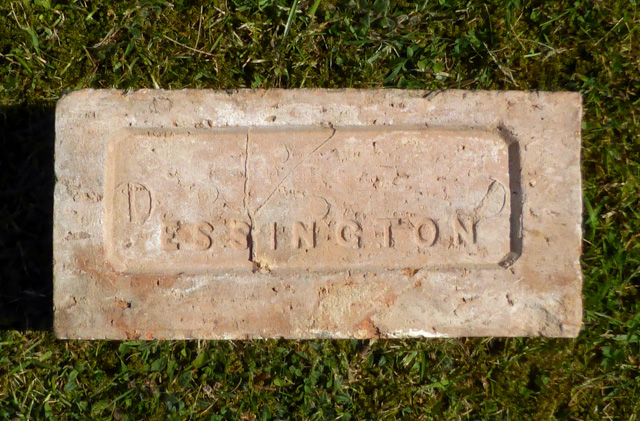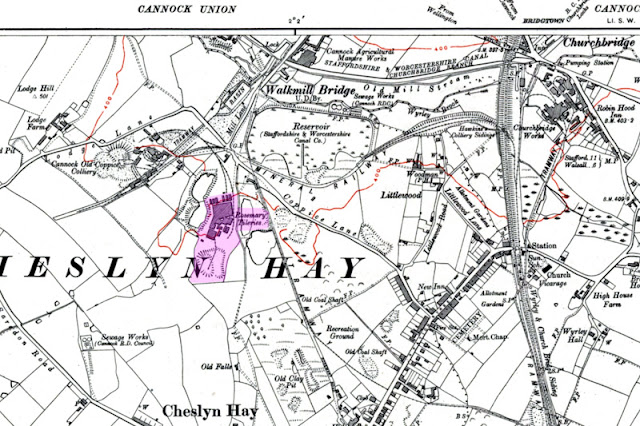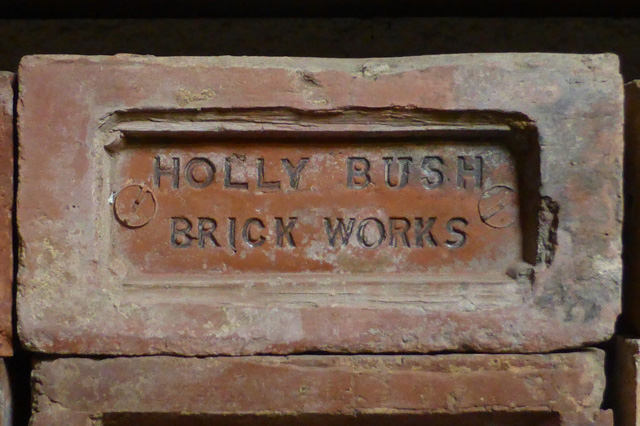NCB Hilton Main
Before writing about Hilton Main Colliery (coloured green on the 1950 OS map below) & brickworks (yellow) situated near Essington, I start with information about Holly Bank Colliery (purple) as the history of these two pits are intertwined. The Holly Bank Coal Co. Ltd. was formed in 1891 to takeover the running of Essington Wood Colliery, after which the pit was renamed Holly Bank. Around 1920 a new pit was sunk to the west of Essington to extract new reserves in that area & this new colliery called Hilton Main was in production by 1924 & was connected underground to Holly Bank. Coal extraction at Holly Bank Colliery had ceased by the General Strike in 1927. Then in 1932 Mr. C.A. Nelson, chairman & managing director of Hartley Main Collieries Ltd in Cramlington, Northumberland purchased the Holly Bank Coal Co. & in doing so in 1935 re-opened Holly Bank Colliery & established a brickworks at Hilton Main. This brickworks consisted of four continuously fired kilns which are clearly shown on the 1950 OS map below (coloured yellow), producing 26,000,000 bricks per annum. With this brick being stamped NCB it will have been made after nationalisation in 1947. I expect bricks made before 1947 were just stamped Hilton Main Colliery - one to look out for as one has yet to be found. A Durham Mining Museum reference last records Holly Bank Colliery as having men underground in 1940, with nil being recorded at the time of Nationalisation. Hilton Main brickworks closed in 1967 & the colliery in 1969.
© Crown Copyright. Reproduced by permission of NLS/Ordnance Survey 1950.
Holly Bank Brickworks
It was first thought that this Holly Bank brick was made at a brickworks situated at Holly Bank Colliery & owned by the Holly Bank Coal Co. which was formed in 1891, but maps dated 1882 & 1900 do not show a marked brickworks at the colliery. Before 1891 this colliery was called Essington Wood & is shown as such on the 1882 OS map below. However this 1882 map has revealed that there was a brick & tile works situated adjacent to Holly Bank House (coloured yellow on the map below) & I think this is where this brick was made. Holly Bank House brickworks is not shown on the 1900 OS map, so it may have only been in production at the time of this 1882 map to the late 1890's. No trade directory entries have been found relating to a brick company or works called Holly Bank, so there is the option that the Holly Bank Coal Co. did owned this brickworks next to Holly Bank House after 1891 & made this brick, but who exactly owned this works before 1891 is not known. I do have one contender & trade directories list Ralph Hawthorn as brickmaker in Essington in Kelly's 1868 to 1880 editions, so he may well have owned this works from the late 1860's to the early 1880's. I think we can date this Holly Bank brick to around 1900 as the style of the frog & stamp mark was also used by Stairfoot & Worksop brick companies around this date. If any firm evidence turns up on the maker of this brick & where it was made, I will update the post.
I next write about the green coloured brickworks as shown on the 1882 map below.
I next write about the green coloured brickworks as shown on the 1882 map below.
© Crown Copyright. Reproduced by permission of NLS/Ordnance Survey 1882.
W. Davis & Co.
W. Davis (blue) is listed in Kelly's 1860 edition at Essington & this entry is followed by W. Davis & Co. (blue), Essington in Kelly's 1868 to 1896 editions. Blue referring to maker of blue bricks, but this example looks more red to me, although it does looks blue on it's edges (faces). The location of Davis's works is shown coloured green on the 1882 map above in the Holly Bank entry.
I have added this Essington brick to this entry as I am unsure who made it. It appears to be the same stamp mark as used by Davis, but without his name on the top line, so possibly made after Davis had sold the works. There is the option that G.W. Lewis who took over this works around 1900 may have made it, but he is only listed in trade directories & an advert as only making blue bricks. As always if I get the answer, I will update the post.
G.W. Lewis & Co.
© Crown Copyright. Reproduced by permission of NLS/Ordnance Survey 1915.
George Warburton Lewis was the next owner of this Hobnock Road brick & tile works at Essington (coloured green on the 1915 map above & named as the Rosemary Brick & Tile Works), taking over from Davis around 1900. Lewis owned another works at Cheslyn Hay making roof tiles & this works is first listed in Kelly's 1876 edition at Rosemary Hill, Cheslyn Hay (shown on the 1915 map below coloured purple). In 1896 Lewis formed his business into a limited company & traded as G.W. Lewis Limited. Lewis owned a third works & I write about that works later.
© Crown Copyright. Reproduced by permission of NLS/Ordnance Survey 1915.
The Rosemary Brick & Tile Works, Essington is first listed in Kelly's 1900 edition as G.W. Lewis Limited, (blue), Essington, Wolverhampton. This entry continues up to the 1912 edition & the reference to blue refers to the making of blue bricks of which there are two examples below which are stamped with his "Rosemary" trade mark name. With Lewis's Cheslyn Hay works being situated on Rosemary Hill one can only assume that is where he took the Rosemary name from to use as his trade mark on his products. The Essington works listing from 1921 does not include blue in the entry, so Lewis may have only made his blue bricks at Essington from 1900 to around 1920 as his primary activity was the production of his well known trade marked brand of machine & hand made "Rosemary" roof tiles at his three works. A BBS 2010 journal article states that the company also made rustic facing bricks.
Tile image courtesy of the Frank Lawson Collection.
The previous directory, Kelly's 1924 edition contains the first listing for Lewis' third works called Walk Mill Tileries, but with having the 1905 advert we know Lewis was operating it in 1905. The 1882 map also shows a clay pit & buildings at this location, but is not named, so there is the option that Lewis may have owned this Walk Mill Tileries works in 1882 ? I have used the 1900 OS map below to show the Walk Mill Works which was north of Cheslyn village next to the Staffordshire & Worcester Canal.
© Crown Copyright. Reproduced by permission of NLS/Ordnance Survey 1900.
The next significant date is 1968 when G.W. Lewis Tileries & the Haunchwood Brick & Tile Co. merged forming Haunchwood - Lewis Brick & Tile Co., but this new company only had a short life as it went into voluntary liquidation in 1973. A BBS article records that all three of Haunchwood's works closed, but no reference is made to the three Lewis works closing at this date. Another search of the web revealed that the Lewis side of this former partnership continued in business as the National Archives holds documents relating to a register of directors/minutes for G.W. Lewis Tileries Ltd up to 1978 & there is the possibly that the company operated as the Rosemary Brick & Tile Company from 1973 as it was this titled company which was purchased by Redland in 1984 according to Redland's timeline page on the web. Today Redland still make the "Rosemary" brand of roofing tiles.
As a footnote I found this page containing photographs of Fred Dibnah demolishing chimney's at the Rosemary Works in 1987, so I expect this will have been the Rosemary Hill Works at Cheslyn Hay.
http://his.brclients.co.uk/shop/?query=cannock&x=36&y=15
Holly Bush Brick Works
Holly Bush Brick Co.
Two January 2023 finds have revealed that the brickworks called Holly Bush Brick Works near Wyrley may have been owned by the owner of Holly Bush Hall & Farm & were the makers of this brick. Location of this works can be seen coloured yellow on the 1900 OS map below. The 1882 OS map also shows the Holly Bush Works. So the first find was a 1882 "For Sale" notice of farm implements & the Works bricks etc & can be seen at this Ebay link. I then did a newspaper search & found the 1876 notice (below) for the sale of bricks at the Holly Bush Brick Works by W.H. Jones of Shareshill. I am assuming this Mr. Jones may have been the works manager & was running the works up to the 1882 Sale Notice. There are no trade directory entries for the Holly Bush Brick Works.
Shropshire Examiner - Friday 03 November 1876 Public domain.
It appears the works stood empty from 1882 until the Holly Bush Brick Co. took over in 1900.
© Crown Copyright. Reproduced by permission of NLS/Ordnance Survey 1900.
The yellow coloured brickworks was run as the Holly Bush Works around 1876 & from 1900 by the Holly Bush Brick Co.
The purple coloured works on the 1900 OS map above is also shown on the 1882 map, so a search of trade directories has revealed the following brickmakers who may have owned the purple brickworks. The 1900 map above also shows an old clay pit, so another pre-1900 brick yard in Cheslyn Hay as well.
These brickmakers are -
Frederick Gilpin, Cheslyn Hay listed in Kelly's 1868, 1872 & 1880 editions;
R. Gilbert, Cheslyn Hay, Kelly's 1868 & 1872 editions;
Birch & Morris, Cheslyn Hay, Kelly's 1876 edition;
Humphrey Wolloxall, Cheslyn Hay, Kelly's 1876 edition;
Alfred Whitehouse, Cheslyn Hay, Kelly's 1880 edition;
Crutchley & Hawkins, Longhouse, Cannock, & at Cheslyn Hay, Kelly's 1888 & 1892 editions;
These brickmakers are -
Frederick Gilpin, Cheslyn Hay listed in Kelly's 1868, 1872 & 1880 editions;
R. Gilbert, Cheslyn Hay, Kelly's 1868 & 1872 editions;
Birch & Morris, Cheslyn Hay, Kelly's 1876 edition;
Humphrey Wolloxall, Cheslyn Hay, Kelly's 1876 edition;
Alfred Whitehouse, Cheslyn Hay, Kelly's 1880 edition;
Crutchley & Hawkins, Longhouse, Cannock, & at Cheslyn Hay, Kelly's 1888 & 1892 editions;
Henry Hawkins, Longhouse, Cannock, & at Cheslyn Hay, Kelly's 1896 & 1900 editions.
Henry Hawkins
Kelly's 1896 & 1900 editions list Henry Hawkins at Longhouse, Cannock, & at Cheslyn Hay, Then only at Longhouse from the 1904 edition. Hawkins Longhouse brickworks is shown on the 1900 OS map below coloured green, as to the location of his Cheslyn Hay works, it may have been the purple coloured works on the 1900 OS map above (best option). The Hawkins family also owned Cannock Old Coppice Colliery also known as Hawkins Colliery up to Nationalisation in 1947 & I have included two bricks made by Hawkins below. See Cheslyn Hay map in Lewis entry for the location of Cannock Old Coppice Colliery. Today the site of Hawkins' Longhouse brickworks is occupied by industrial units.
With the name being stamped on face of the brick it will be a fairly modern example.
© Crown Copyright. Reproduced by permission of NLS/Ordnance Survey 1900.
It is unknown if this brick was made at a brickworks next to the colliery or if it was made at the Longhouse Brickworks (preferred option) situated on the other side of the Staffordshire & Worcester Canal.
With the name being stamped on face of the brick it will be a fairly modern example.



















